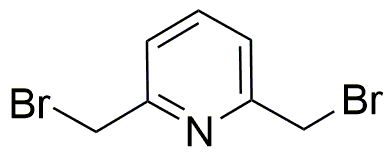2,6-Bis(bromomethyl)pyridine is widely utilized in research focused on:
- Synthesis of Pharmaceuticals: This compound serves as an important intermediate in the synthesis of various pharmaceutical agents, particularly those targeting neurological disorders.
- Polymer Chemistry: It is used in the development of specialty polymers, enhancing properties such as thermal stability and chemical resistance, making it valuable in the manufacturing of high-performance materials.
- Organic Synthesis: Researchers employ this compound in organic synthesis processes, particularly in the creation of complex organic molecules, due to its reactivity and ability to introduce bromomethyl groups.
- Bioconjugation: Its functional groups allow for effective bioconjugation techniques, which are essential in creating targeted drug delivery systems and diagnostic agents in biomedicine.
- Research in Material Science: The compound is explored in the field of material science for developing new coatings and adhesives that require enhanced adhesion properties and durability.
Información general
Propiedades
Seguridad y normativas
Aplicaciones
2,6-Bis(bromomethyl)pyridine is widely utilized in research focused on:
- Synthesis of Pharmaceuticals: This compound serves as an important intermediate in the synthesis of various pharmaceutical agents, particularly those targeting neurological disorders.
- Polymer Chemistry: It is used in the development of specialty polymers, enhancing properties such as thermal stability and chemical resistance, making it valuable in the manufacturing of high-performance materials.
- Organic Synthesis: Researchers employ this compound in organic synthesis processes, particularly in the creation of complex organic molecules, due to its reactivity and ability to introduce bromomethyl groups.
- Bioconjugation: Its functional groups allow for effective bioconjugation techniques, which are essential in creating targeted drug delivery systems and diagnostic agents in biomedicine.
- Research in Material Science: The compound is explored in the field of material science for developing new coatings and adhesives that require enhanced adhesion properties and durability.
Documentos
Hojas de datos de seguridad (HDS)
La SDS proporciona información de seguridad completa sobre la manipulación, el almacenamiento y la eliminación del producto.
Especificación del producto (PS)
La PS proporciona un desglose completo de las propiedades del producto, incluida la composición química, el estado físico, la pureza y los requisitos de almacenamiento. También detalla los rangos de calidad aceptables y las aplicaciones previstas del producto.
Certificados de análisis (COA)
Busque certificados de análisis (COA) ingresando el número de lote del producto. Los números de lote y de partida se pueden encontrar en la etiqueta de un producto después de las palabras "Lote" o "Lote".
Número de catálogo
Número de lote/lote
Certificados de origen (COO)
Este certificado de origen confirma el país en el que se fabricó el producto y también detalla los materiales y componentes utilizados en él y si se deriva de fuentes naturales, sintéticas u otras fuentes específicas. Este certificado puede ser necesario para cumplir con las normativas aduaneras, comerciales y regulatorias.
Número de catálogo
Número de lote/lote
Hojas de datos de seguridad (HDS)
La SDS proporciona información de seguridad completa sobre la manipulación, el almacenamiento y la eliminación del producto.
DownloadEspecificación del producto (PS)
La PS proporciona un desglose completo de las propiedades del producto, incluida la composición química, el estado físico, la pureza y los requisitos de almacenamiento. También detalla los rangos de calidad aceptables y las aplicaciones previstas del producto.
DownloadCertificados de análisis (COA)
Busque certificados de análisis (COA) ingresando el número de lote del producto. Los números de lote y de partida se pueden encontrar en la etiqueta de un producto después de las palabras "Lote" o "Lote".
Número de catálogo
Número de lote/lote
Certificados de origen (COO)
Este certificado de origen confirma el país en el que se fabricó el producto y también detalla los materiales y componentes utilizados en él y si se deriva de fuentes naturales, sintéticas u otras fuentes específicas. Este certificado puede ser necesario para cumplir con las normativas aduaneras, comerciales y regulatorias.

